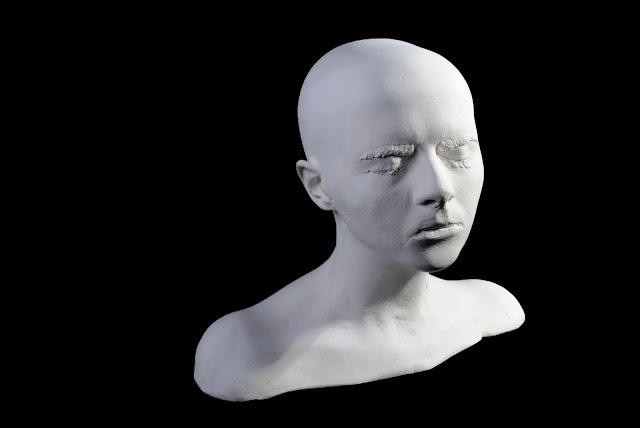This was my first piece of my second year on my Extended Diploma in Art & Design, produced for my initial exploratory project in 3D. At the start of this year, I took two specialist subjects - Fine Art and 3D - and currently have dropped down to just 3D for my Final Major Project. This piece was actually the decider for me when choosing which subject I wanted to continue with - Skin Has No Roots being the piece I produced for Fine Art.
What I pride myself on is my interest in learning as many skills as possible so as to bring my ideas to life as fully as possible; while I'm adept at painting and drawing, some of the concepts I think up don't work particularly well in those dimensions. I like the feel of creating objects - I think that people look at them differently to paintings or drawings, because while a canvas may be a 3D object, what appears on it is viewed as though it is 2D.
Looking at something truly in 3 dimensions is utterly different. I like the fact that the process is often more decipherable in 3D things than in 2D things - one of the joys of going to galleries for me is studying the works and trying to figure out how the artist approached making them, and seeing if you can think of a better way of going about it. I don't think that you can do that so much with more traditional fine art media, because so much of that is intuitive; we can understand how they applied the paint, what they used to make that line, but we cannot possibly fathom how they decided to place colour, or why they used the strokes they did. So much of deciphering paintings or drawings is speculation, and I personally prefer leaving my concept to speculation - I like the idea that someone might look at my work and be interested in the process.
I'm obsessed with skills. I love learning how people have created things, and how they have manipulated materials to their whim. Anyways, I digress.
Apotheosis (2011-2012) was produced for the project brief of 'Autobiography'; we started by looking at suitcases and filling them with cherished items, and moved on from there. A lot of us stayed within the constraints of our suitcases, and others (like me) branched out.
In my suitcase, I had included an artist's mannequin. You know, the small ones you buy to learn the proportions of the human body? I've had one for years. I first asked for one when I was very young, and to me it was very representative of the love I have for the human form. I am fascinated by bodies of all shapes and sizes, and I think that society - well, Western society at least - conditions us to fear them. I have never viewed my body or my face as something fearful, nor do I think it is of great importance past being a vehicle for the important things; my brain, my organs. I care for my body in that I would like for it to be healthy so that it can transport and house me (the metaphysical entity) for as long as it can.
I looked at the mannequin as an object for a while, producing plaster casts of it and suchlike, until I eventually moved into using my own body. I produced a few sand impressions of my face and cast them in plaster - I liked the distorted look I achieved, but wanted to take the concept further.
In terms of process, this was the end result of a long period of experimentation with different forms of plaster casting. For the bust, I investigated alginate as a mould-making material, using both dental and regular alginate at different points. The bust was cast from a mould made of modroc and alginate - modroc over the back of my head and shoulders, and alginate reinforced by modroc at the front. The moulds for the wax masks were vacuum-formed plastic sheets, taken from existing work or objects. I had three people help create the mould, and to help me cast from it after its creation.
It was this experience of being cast which led me to consider gender; when I initially cast a simple death mask as an experiment with materials, I was interested in how ungendered my face appeared when without make-up or a hairstyle to act as a gender signifier. Indeed, even such signifiers can often be inaccurate, and based on societal norms of gender. I wanted to look at the fluidity of gender further, and this led me to produce the bust.
The masks, on the other hand, were a result of considering what all people have in common. When Apotheosis is shown, the bust is placed on a plinth with the masks suspended and coming away from the face. The first is a blurred, yet realistic mask of my face, still as in death. The second is red, representative of the flesh beneath everyone's exterior. The third is a black skull, reminiscent of the skulls of pharaohs recovered from their tombs, indicative of the fate we all share. In death, we are the same.
The name, Apotheosis, means to turn someone or something into a deity. What I meant to create when I conceived the piece was an altar to humanity's similarities, regardless of gender, race, sex or class. As they say, death is the great equalizer.






No comments:
Post a Comment